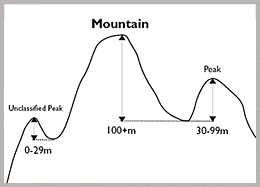Scandinavian Mountains over 2000 metres - James Baxter
Introduction › Massifs, Mountains & Peaks
In this book I have tried to distinguish between a massif, a mountain and a peak. To distinguish between the three it is useful to rely on geographical, and in particular glacial, processes.
Massifs
A massif is a distinct mountainous region, often with many unifying features like geology, climate, vegetation and natural history which give it a consistent character.
The mountainous massifs in Scandinavia have been separated from other massifs by an awesome glacial process over the last 50 million years. This process is the flow of secondary glaciers which have drained the upland icefields and whose abrasive power has carved deep arterial valleys into the earth's surface.
These deep gashes separated the massifs once the ice had disappeared from them and now not only are obvious physical dividers but tend to act as boundaries to weather patterns, climate and natural history, encouraging us to think of each massif as a unique microcosm.
Utladalen, on the east of Hurrungane, and its northwards extension Leirdalen, on the east of the Smørstabb massif, are two prime examples of these secondary glacial valleys which separate massifs and also tend to be weather divides. In mainland Scandinavia today these secondary arterial glaciers have all disappeared.
Mountains
Each massif boasts individual mountains. Frequently the mountains in a given massif are of a similar character and height.
These mountains are often separated by the actions of the primary glaciers. The primary glaciers often radiate away from the centre of the massif and flow into the secondary glaciers. They gnaw into the heart of the massif, gouging out deep corries and valleys as they flowed away to meet the arterial secondary glaciers.
Sometimes the headwalls of adjacent corries would be eaten away completely by the glacier to leave a pass. As they radiated away they would carve deep valleys separated by high ridges. Hurrungane is a magnificent example of this type of primary glaciation and has five superb adjacent valleys on its south east side attributable to it.
This type of glaciation produced passes, deep obvious saddles and might have even split the main massif into two or three mini-massifs, as happened in Hurrungane with the Fannaråken complex to the north and the main complex to the south. The saddles produced by the general actions of this primary glaciation are generally over 100m but less than 500m. This is the case in most mountainous areas in Scandinavia.
I therefore consider a mountain to have at least 100m of ascent from the highest saddle for it to qualify as a separate mountain.
Peaks
A mountain may support a number of peaks. Some mountains, like Store Skagastølstind, may have four seperate peaks on its ridges while others, like Fannaråken, have none. These peaks have usually been created by glacial action on the saddles in the highest reaches of the accumulation zones of the primary glaciers, creating some smaller corries within the main corrie. Frost shattering and the erosion of bands of softer rock can also create the saddles between peaks.
 Usually peaks are found on the ridges leading down from the mountain. They may be very impressive and difficult to climb, like the aforementioned Skagastøls ridge peaks, or they might be dull undulations in a ridge like those on the south ridge of Bukkehøi.
Usually peaks are found on the ridges leading down from the mountain. They may be very impressive and difficult to climb, like the aforementioned Skagastøls ridge peaks, or they might be dull undulations in a ridge like those on the south ridge of Bukkehøi.
When the actions which create peaks continue over a longer period the topography of the mountain and its ridges may change sufficiently for a deep enough saddle to create a separate mountain. This has been the case on the Styggedals ridge. Eventually, erosion of the saddles on the Skagastøls ridge will elevate these four peaks into mountains also, providing the tops remain largely unshattered by frost.
Sometimes a peak on a moutain may be much harder to climb than the mountain itself, like Hettpiggen on the easy Snøhetta in Dovrefjell.
The processes which create these saddles on the ridges of the mountains, like perpherial glaciation and frost shattering, may create saddles of 30m or more once they have been established a while.
I therefore consider a peak to have at least 30m of ascent from the highest saddle for it to qualify as a separate peak on the mountain on which it is located. If the saddle is less than 30m I have not classified the peak at all.
Classification
This is of course a generalization, and there are some exceptions. However, it does allow us to classify all the Scandinavian 2000m tops into separate mountains and their associated peaks based on a geographical argument.
A full list of all the mountains in Scandinavia which are over 2000m are given in the apendix at the end of the book. Their associated peaks are also listed. As this series of 7 books unfolds, these mountains and their associated peaks will be described as each of the regions are covered.



